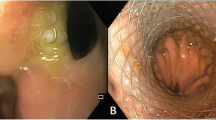Abstract
Esophageal leak is a life-threatening problem that can result from spontaneous rupture of the esophagus, cancer, anastomotic dehiscence after surgery, or as a complication of endoscopy. During the last decade, developments in the minimally invasive endoluminal approach to the management of esophageal leaks include utilization of endoscopy not only for diagnosis but also for closure of leaks with clips or sutures, bypass of the leaks with stents, and/or endoluminal drainage of mediastinal infection. The aim of this review is to summarize recent advances and the principles of endoscopic management of acute esophageal perforations.
Similar content being viewed by others
References
Papers of particular interest, published recently, have been highlighted as: • Of importance •• Of major importance
•• Bhatia P, Fortin D, Inculet RI, Malthaner RA. Current concepts in the management of esophageal perforations: a twenty-seven year Canadian experience. Ann Thorac Surg. 2011;92(1):209–15. This is a retrospective review of 27 years experience of a single center in the management of esophageal perforations.
• Qadeer MA, Dumot JA, Vargo JJ, Lopez AR, Rice TW. Endoscopic clips for closing esophageal perforations: case report and pooled analysis. Gastrointest Endosc. 2007;66(3):605–11. Case report of the use of clips, however at the end is a systematic review of the use of clips.
Raju GS, Thompson C, Zwischenberger JB. Emerging endoscopic options in the management of esophageal leaks (videos). Gastrointest Endosc. 2005;62(2):278–86.
•• Sepesi B, Raymond DP, Peters JH. Esophageal perforation: surgical, endoscopic and medical management strategies. Curr Opin Gastroenterol. 2010;26(4):379–83. Review article by current opinion in Gastroenterology about esophageal perforations regarding surgical, endoscopic and medical management.
Raju GS. Gastrointestinal perforations: role of endoscopic closure. Curr Opin Gastroenterol. 2011;27(5):418–22.
•• Low DE. Diagnosis and management of anastomotic leaks after esophagectomy. J Gastrointest Surg. 2011;15(8):1319–22. Review article with a proposed algorithm for diagnosis and management of post-esophagectomy leaks.
Fritscher-Ravens A, Hampe J, Grange P, Holland C, Olagbeye F, Milla P, et al. Clip closure versus endoscopic suturing versus thoracoscopic repair of an iatrogenic esophageal perforation: a randomized, comparative, long-term survival study in a porcine model (with videos). Gastrointest Endosc. 2010;72(5):1020–6.
Voermans RP, Le Moine O, von Renteln D, Ponchon T, Giovannini M, Bruno M, et al. Efficacy of endoscopic closure of acute perforations of the gastrointestinal tract. Clin Gastroenterol Hepatol. 2012;10(6):603–8.
Markar SR, Koehler R, Low DE, Ross A. Novel multimodality endoscopic closure of postoperative esophageal fistula. Int J Surg Case Rep. 2012;3(11):577–9.
Zolotarevsky E, Kwon Y, Bains M, Schattner M. Esophagobronchial fistula closure using a novel endoscopic over-the-scope-clip. Ann Thorac Surg. 2012;94(3):e69–70.
Manta R, Manno M, Bertani H, Barbera C, Pigo F, Mirante V, et al. Endoscopic treatment of gastrointestinal fistulas using an over-the-scope clip (OTSC) device: case series from a tertiary referral center. Endoscopy. 2011;43(6):545–8.
Pohl J, Borgulya M, Lorenz D, Ell C. Endoscopic closure of postoperative esophageal leaks with a novel over-the-scope clip system. Endoscopy. 2010;42(9):757–9.
Surace M, Mercky P, Demarquay JF, Gonzalez JM, Dumas R, Ah-Soune P, et al. Endoscopic management of GI fistulae with the over-the-scope clip system (with video). Gastrointest Endosc. 2011;74(6):1416–9.
Gill KR, Pooley RA, Wallace MB. Magnetic resonance imaging compatibility of endoclips. Gastrointest Endosc. 2009;70(3):532–6.
Kiev J, Amendola M, Bouhaidar D, Sandhu BS, Zhao X, Maher J. A management algorithm for esophageal perforation. Am J Surg. 2007;194(1):103–6.
•• D'Cunha J, Rueth NM, Groth SS, Maddaus MA, Andrade RS. Esophageal stents for anastomotic leaks and perforations. J Thorac Cardiovasc Surg. 2011;142(1):39–46 e31. Comprehensive review on esophageal stents in 37 patients. They propose a good treatment algorithm based on experience only.
Dai Y, Chopra SS, Kneif S, Hunerbein M. Management of esophageal anastomotic leaks, perforations, and fistulae with self-expanding plastic stents. J Thorac Cardiovasc Surg. 2011;141(5):1213–7.
Rollins MD, Barnhart DC. Treatment of persistent esophageal leaks in children with removable, covered stents. J Pediatr Surg. 2012;47(10):1843–7.
Wedemeyer J, Schneider A, Manns MP, Jackobs S. Endoscopic vacuum-assisted closure of upper intestinal anastomotic leaks. Gastrointest Endosc. 2008;67(4):708–11.
Loske G, Schorsch T, Muller C. Endoscopic vacuum sponge therapy for esophageal defects. Surg Endosc. 2010;24(10):2531–5.
Kuehn F, Schiffmann L, Rau BM, Klar E. Surgical endoscopic vacuum therapy for anastomotic leakage and perforation of the upper gastrointestinal tract. J Gastrointest Surg. 2012.
Ahrens M, Schulte T, Egberts J, Schafmayer C, Hampe J, Fritscher-Ravens A, et al. Drainage of esophageal leakage using endoscopic vacuum therapy: a prospective pilot study. Endoscopy. 2010;42(9):693–8.
Loske G, Schorsch T, Muller C. Intraluminal and intracavitary vacuum therapy for esophageal leakage: a new endoscopic minimally invasive approach. Endoscopy. 2011;43(6):540–4.
Conflict of Interest
Rene Gomez-Esquivel declares that he has no conflict of interest.
G. S. Raju declares that he has no conflict of interest.
Author information
Authors and Affiliations
Corresponding author
Additional information
This article is part of the Topical Collection on Esophagus
Rights and permissions
About this article
Cite this article
Gomez-Esquivel, R., Raju, G.S. Endoscopic Closure of Acute Esophageal Perforations. Curr Gastroenterol Rep 15, 321 (2013). https://doi.org/10.1007/s11894-013-0321-9
Published:
DOI: https://doi.org/10.1007/s11894-013-0321-9




